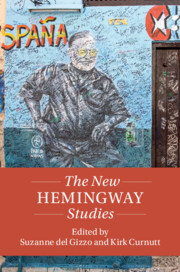48 results
Chapter 1 - Youth, Maturation, and Adult Sexuality
-
-
- Book:
- The Cambridge Companion to F. Scott Fitzgerald
- Published online:
- 26 October 2023
- Print publication:
- 09 November 2023, pp 15-37
-
- Chapter
- Export citation
Reading Smile: History, Myth and American Identity in Brian Wilson and Van Dyke Parks’ Long-Lost Album. By Dale Carter. London: Routledge, 2021. 166 pp. ISBN: 978-0-367-62286-2
-
- Journal:
- Popular Music / Volume 42 / Issue 2 / May 2023
- Published online by Cambridge University Press:
- 13 April 2023, pp. 218-221
- Print publication:
- May 2023
-
- Article
- Export citation
Contents
-
- Book:
- The New Hemingway Studies
- Published online:
- 30 August 2020
- Print publication:
- 17 September 2020, pp v-vi
-
- Chapter
- Export citation
Part I - The Textual Hemingway
-
- Book:
- The New Hemingway Studies
- Published online:
- 30 August 2020
- Print publication:
- 17 September 2020, pp 15-96
-
- Chapter
- Export citation
Copyright page
-
- Book:
- The New Hemingway Studies
- Published online:
- 30 August 2020
- Print publication:
- 17 September 2020, pp iv-iv
-
- Chapter
- Export citation
Part II - Identities
-
- Book:
- The New Hemingway Studies
- Published online:
- 30 August 2020
- Print publication:
- 17 September 2020, pp 97-186
-
- Chapter
- Export citation
Index
-
- Book:
- The New Hemingway Studies
- Published online:
- 30 August 2020
- Print publication:
- 17 September 2020, pp 302-312
-
- Chapter
- Export citation
Conclusion
- from Part III - Global Engagements
-
- Book:
- The New Hemingway Studies
- Published online:
- 30 August 2020
- Print publication:
- 17 September 2020, pp 255-258
-
- Chapter
- Export citation
Introduction - Hemingway in the New Millennium
-
-
- Book:
- The New Hemingway Studies
- Published online:
- 30 August 2020
- Print publication:
- 17 September 2020, pp 1-14
-
- Chapter
- Export citation
Contributors
-
- Book:
- The New Hemingway Studies
- Published online:
- 30 August 2020
- Print publication:
- 17 September 2020, pp vii-x
-
- Chapter
- Export citation
Works Cited
-
- Book:
- The New Hemingway Studies
- Published online:
- 30 August 2020
- Print publication:
- 17 September 2020, pp 259-301
-
- Chapter
- Export citation
Part III - Global Engagements
-
- Book:
- The New Hemingway Studies
- Published online:
- 30 August 2020
- Print publication:
- 17 September 2020, pp 187-258
-
- Chapter
- Export citation
Chapter 1 - Shaping the Life
- from Part I - The Textual Hemingway
-
-
- Book:
- The New Hemingway Studies
- Published online:
- 30 August 2020
- Print publication:
- 17 September 2020, pp 17-32
-
- Chapter
- Export citation

The New Hemingway Studies
-
- Published online:
- 30 August 2020
- Print publication:
- 17 September 2020
Index
-
- Book:
- American Literature in Transition, 1970–1980
- Published online:
- 27 February 2018
- Print publication:
- 22 March 2018, pp 440-454
-
- Chapter
- Export citation
Chronology
-
- Book:
- American Literature in Transition, 1970–1980
- Published online:
- 27 February 2018
- Print publication:
- 22 March 2018, pp xiv-xviii
-
- Chapter
- Export citation
Contents
-
- Book:
- American Literature in Transition, 1970–1980
- Published online:
- 27 February 2018
- Print publication:
- 22 March 2018, pp v-vii
-
- Chapter
- Export citation
Part III - Cultural Engagements
-
- Book:
- American Literature in Transition, 1970–1980
- Published online:
- 27 February 2018
- Print publication:
- 22 March 2018, pp 241-380
-
- Chapter
- Export citation
Conclusion
-
-
- Book:
- American Literature in Transition, 1970–1980
- Published online:
- 27 February 2018
- Print publication:
- 22 March 2018, pp 381-387
-
- Chapter
- Export citation
Contributors
-
- Book:
- American Literature in Transition, 1970–1980
- Published online:
- 27 February 2018
- Print publication:
- 22 March 2018, pp ix-xiii
-
- Chapter
- Export citation



